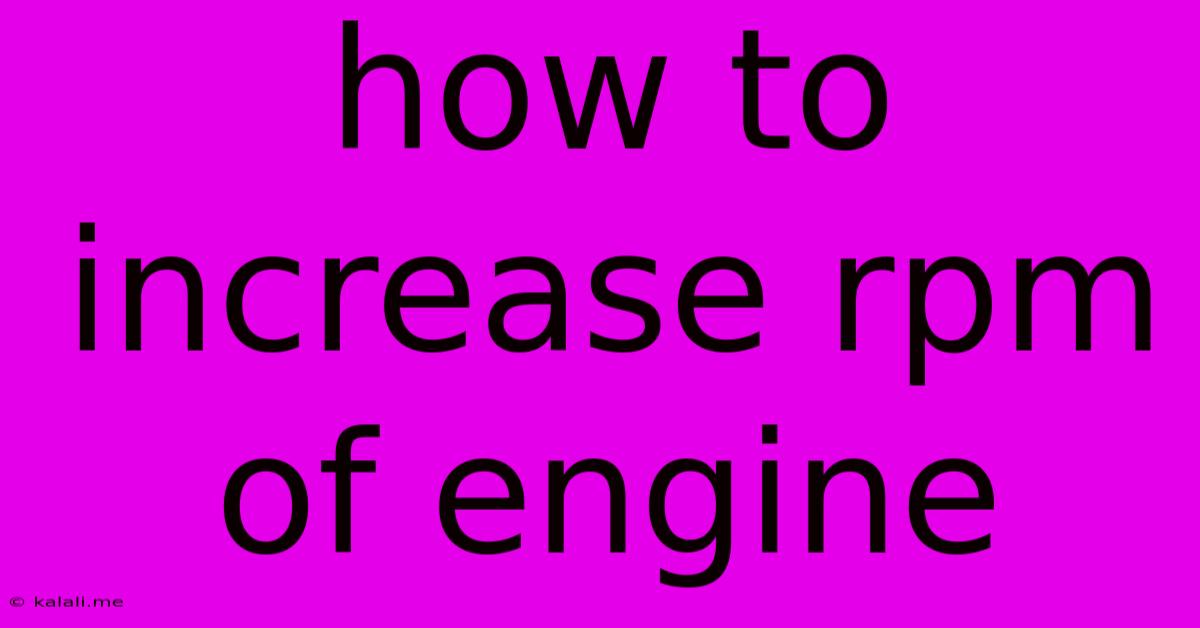How To Increase Rpm Of Engine
Kalali
May 31, 2025 · 3 min read

Table of Contents
How to Increase Engine RPM: A Comprehensive Guide
Meta Description: Learn how to safely and effectively increase your engine's RPM, covering factors influencing RPM, modifications for increased performance, and crucial safety precautions. Discover the best practices for maximizing your engine's potential.
Increasing your engine's RPM (revolutions per minute) can lead to significant performance gains, but it's crucial to understand the process and its limitations. This guide will walk you through various methods, highlighting safety considerations and offering practical advice for achieving higher RPM safely and effectively.
Understanding Engine RPM and its Limits
Before delving into methods for increasing RPM, it’s vital to understand what influences it. Engine RPM is directly related to the engine's speed and power output. Factors influencing your engine's RPM include:
- Throttle Position: The more you open the throttle, the more fuel and air enter the combustion chamber, leading to higher RPM.
- Engine Load: Heavier loads (e.g., towing, climbing hills) will decrease RPM, as the engine works harder.
- Gear Ratio: Lower gears allow for higher RPM at lower vehicle speeds, while higher gears result in lower RPM at higher speeds.
- Engine Modifications: Alterations like performance exhaust systems, upgraded air intake systems, and engine tuning can significantly impact RPM capabilities.
It's important to recognize that every engine has a redline, representing the maximum RPM it can safely operate at. Exceeding the redline can cause severe engine damage, including:
- Broken connecting rods
- Blown head gaskets
- Damaged pistons
Always respect your engine's redline and avoid pushing it beyond its limits.
Methods to Increase Engine RPM (Within Safe Limits)
Increasing your engine RPM safely often involves a combination of strategies. Remember, drastic modifications should only be undertaken by experienced mechanics.
-
Improve Air Intake: A more efficient air intake system allows more air into the engine, supporting higher RPM. Consider upgrading to a high-flow air filter or a cold air intake system. This is generally a less invasive modification compared to others.
-
Enhance Exhaust System: A performance exhaust system reduces back pressure, enabling the engine to breathe more freely and potentially achieve higher RPM. Look for exhaust systems with larger diameter piping and less restrictive mufflers.
-
Engine Tuning (ECU Tuning): This advanced method involves reprogramming the engine control unit (ECU) to optimize fuel delivery and ignition timing for higher RPM operation. This should only be done by professionals with specialized software and knowledge. Incorrect ECU tuning can severely damage your engine.
-
Gear Selection: Downshifting to a lower gear allows the engine to operate at higher RPM for better acceleration and climbing hills. This is a driver-controlled method to effectively achieve higher RPM without modifying the engine itself.
-
Regular Maintenance: Ensuring your engine is properly maintained, including regular oil changes, spark plug replacements, and air filter cleaning, contributes to optimal engine performance and potentially higher RPM within its safe operating range. This is crucial for longevity and preventing unnecessary wear and tear.
Safety Precautions: Always Prioritize Safety
- Never exceed the redline RPM: This is paramount to prevent catastrophic engine failure.
- Listen for unusual noises: Any knocking, rattling, or unusual sounds indicate a potential problem. Stop immediately and have your engine inspected.
- Monitor engine temperature: Overheating can severely damage your engine. Ensure your cooling system is functioning correctly.
- Regular engine checks: Conduct regular inspections to identify potential issues early on.
- Consult a professional: If you're unsure about any modifications, consult a qualified mechanic.
By understanding the factors influencing engine RPM and taking necessary precautions, you can safely explore methods to increase your engine’s RPM and unlock its full potential while maintaining its longevity and reliability. Remember, gradual improvements and professional advice are key to ensuring a safe and successful outcome.
Latest Posts
Latest Posts
-
How To Uninstall An D Reinstal Dlc Steamn
Jun 01, 2025
-
Is Cayenne Pepper Same As Chili Powder
Jun 01, 2025
-
Its Not Going To Suck Itself
Jun 01, 2025
-
2 Wire Ceiling Fan To 3 Wire
Jun 01, 2025
-
Long Cage Derailleur Vs Short Cage
Jun 01, 2025
Related Post
Thank you for visiting our website which covers about How To Increase Rpm Of Engine . We hope the information provided has been useful to you. Feel free to contact us if you have any questions or need further assistance. See you next time and don't miss to bookmark.